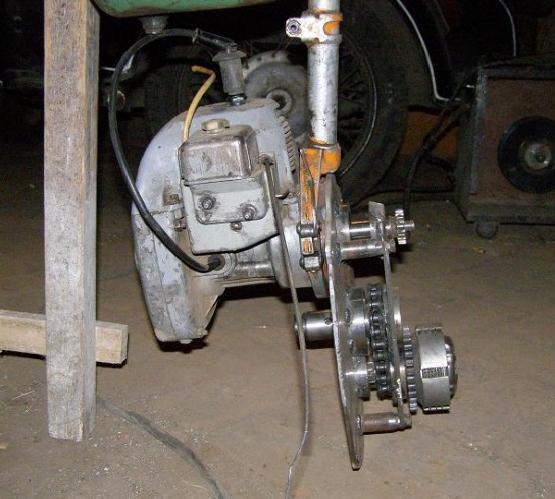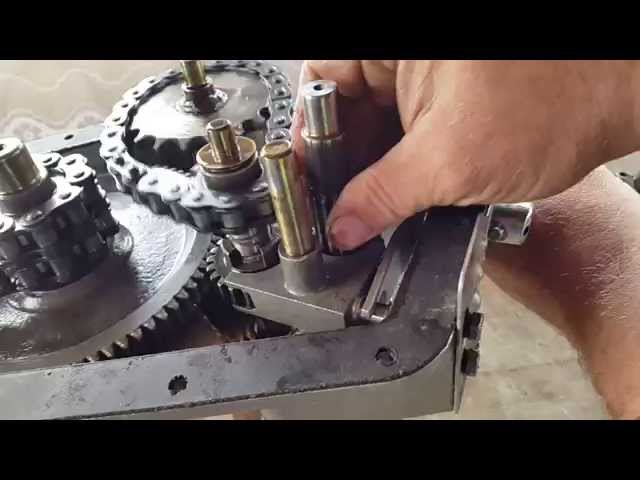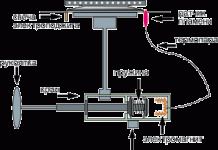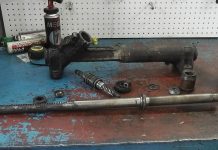The material presented in this article is especially in demand for people who repair their equipment on their own. Further, the main "subtleties" regarding the repair of the motoblock gearbox will be touched upon. To go directly to the topic of repair, you need to understand the gearbox design. Looking ahead, it is necessary to say: the structure of the gearboxes of modern walk-behind tractors is similar to each other, there are only minor differences in one or another model.
So that the question "How to disassemble the gearbox of a walk-behind tractor?" Does not arise, you need to be familiar with all the details. We list the main parts and components of any modern walk-behind tractor: covers and pulley; bushings with bearings; lever, axle and shift fork; input shaft block with gear; input and output shaft of the motoblock gearbox. Components: washers and seals; right and left semiaxis; clutch and clutch fork; bracket and spring.
In most cases, problems in the gearbox of the walk-behind tractor arise due to overloads. Such breakdowns include the bursting of the bushings on the metal chain, which leads to the so-called "slip". Also, owners of walk-behind tractors very often find broken gearshift bushings. In order to avoid such troubles, experienced owners advise to switch gears only during a complete stop of the equipment, in no case on the move. In addition, star breakage is considered to be a common phenomenon. That is, factory welding is not enough for the star to withstand the overload.
It is very easy to "get out" of this annoying situation, you just need to return the star to its original position and grab it by welding with much better quality. Lateral loads lead to wear of the support washer, after which the bushings come off the chain. In addition to the above, it is necessary to periodically check the oil level in the gearbox and replace it.
Monitor the amount of oil constantly. Otherwise, neglect of technology will lead to fatal consequences. Fresh oil is poured every 50 hours. Along with this, excessive loads should be avoided, which ultimately lead to the rapid development of mechanisms and components. Let's go directly to changing the oil:
The filling oils must be GOST. It makes no sense to use cheap oil, because sooner or later, it will cause breakdowns inside the gearbox of the walk-behind tractor.
Valve adjustment on 168F, 170F motors.
And (Augustyna) one prerequisite, for correct adjustment, the engine must be completely cooled down, the ambient temperature and, accordingly, the engine must be within + 15 to +20 degrees.
Motoblocks SALUT (AGAT), FAVORIT, MKM "LANDER", NEVA. The topic is not about engine operation, but about valve adjustment.
VIDEO
The service center repairs Favorit motoblocks, repairs Neva motoblocks, repairs. Comments are disabled for this video.
Before repairing a walk-behind tractor with your own hands, it is advisable to familiarize yourself with the diagram of your walk-behind tractor.
until this spring everything was great, but now he let us down, went through all the diagnostics before working in the country, poured oil, gasoline, went into the field, after 20 minutes. work began to stall, then he died completely, what is the reason still not figured out, gasoline comes in, there is a spark. Maybe someone came across!
Nadezhda Perhaps the air filter is dirty and it is not a bad idea to change the candle.
Instructions for the photo gallery “Gallery 2”. ... From 01.04.96, an ignition circuit is installed in MB-2 "Neva" motoblocks. "Repair of the starting device".
Diagnostics of malfunctions and repair of the engine. Possible. The walk-behind tractor engine does not start, the candle is wet. 1. Failure in the ignition system :.
Motoblocks can significantly facilitate work on a personal plot. This is a compact agricultural machinery with high functionality and versatility. With its help, you can not only loosen the soil, but also carry out the basic activities for the care of plants and harvesting.
Like any other technique, walk-behind tractors sometimes fail. Fortunately, they have a relatively simple design, and you can even carry out simple repairs with your own hands. To do this, you need to learn how to determine which part of the walk-behind tractor is out of order, and what needs to be done to restore the operation of the equipment. Our article will help you with this, which not only describes the principle of operation of the walk-behind tractor, but also the main causes of equipment malfunction and how to eliminate them.
Most of the models consist of the same parts, so you can do the repair of the main components yourself.
Each walk-behind tractor consists of a base frame, a gasoline or diesel engine, a fuel tank, a rotor for attaching cutters, wheels and a bracket for fixing attachments. The most important component is, of course, the engine, on the successful operation of which the operation of the equipment will depend (Figure 1). In addition, modern models have fuel supply, cooling, ignition and gas distribution systems, and the occurrence of malfunctions in them can also lead to a shutdown of the unit.
The main function of the walk-behind tractor is to loosen the soil using special cutters that are attached to the frame of the device.
Note: Unlike a conventional plow, the cutter does not overturn the soil and prevents soil erosion.
In addition, the technique can be used to loosen row spacings in the process of growing agricultural crops, and special attachments are useful for harvesting. Simple models (cultivators) consist of several wheels and handles that are used to control the machinery. On the handles there are buttons necessary for control. More powerful and modern models are mini tractors without a cab. In this case, control is carried out by buttons and pedals located on the dashboard.
Despite the fact that walk-behind tractors are produced by a wide variety of manufacturers, it is customary to divide all such equipment into types depending on weight and power (Figure 2).
According to this criterion, walk-behind tractors are:
Ultralight - weighing up to 15 kg;
Lightweight (about 40 kg);
Medium - from 45 to 60 kg;
Heavy (over 60 kg).
As a rule, all types of equipment are supplied with an internal combustion engine with a capacity of 1.5 to 10 horsepower. This is necessary in order for even the ultra-light model to successfully cope with loosening the soil in areas with heavy and dense soils.
Since the main part of any technique is the engine, the main number of breakdowns is associated with it (Figure 3).In some cases, poor engine performance may be associated with poor-quality fuel or dirty air filter. There are also cases that the engine does not work properly due to insufficient heating, malfunctions of the ignition system, carburetor or pistons.
We will try to understand the main types of damage to the walk-behind tractor, which can be eliminated with our own hands. However, if you are not confident in your own abilities or are afraid that it is impossible to fix the malfunction on your own, it is better to contact a specialist.
If the engine does not start when you try to start, there may be a problem with the engine itself or its starting system.
To troubleshoot fuel supply problems, do the following:
Check the spark plugs: if they are dry, it means that no fuel is entering the engine cylinders. Such a malfunction can occur when blockages form in the gas tank cap, debris gets into the fuel supply system, when the supply valve is closed or the banal lack of gasoline.
Refuel the tank and try to start the engine again.
Check the fuel cock: if it is closed, it must be repositioned to open.
Clean the fuel tank drain hole.
Drain the gasoline tank, remove the fuel cock and rinse it with clean gasoline.
Remove the connecting hose near the carburetor and blow it out (together with the jets).
If all these manipulations did not help, and the fuel enters the carburetor, but does not enter the cylinder, then the malfunction is in the carburetor and this part must be carefully examined.
A common cause of carburetor malfunction is blockages. In this case, it is enough to disassemble the part, remove the source of pollution and reassemble. The instructions, which are necessarily provided by the manufacturer, will help you with this (Figure 4).
The main purpose of all manipulations with the carburetor is to adjust the immersion of the float, which is attached with a bracket to the piston system. It often happens that the bracket is deformed, the float does not sink correctly and the carburetor does not function properly. The bracket is adjusted with an ordinary screwdriver, both with the needle valve open and closed.
After correcting the carburetor, it is recommended to also check the serviceability of the valves. It is necessary to check the tightness of each of them and, if necessary, restore the optimal clearance.
It often happens that during the operation of the walk-behind tractor, extraneous noises appear in its gearbox. As a rule, this is due to an insufficient amount of oil in it, and to eliminate the malfunction, it is enough just to add fluid to the gearbox (Figure 5).
However, if there is enough oil in the gearbox and the noise persists, the brand and grade of oil may not be suitable for your model. In this case, the oil must be completely drained, the system flushed and refilled with new, more suitable oil.
In addition, extraneous noise may be associated with insufficient fixation of the transmission elements. They must be inspected and, if necessary, tightened. It should also be borne in mind that the gearbox elements must be inspected and replaced in a timely manner when the first signs of wear are detected. This way you can avoid more serious repairs in the future.
Engine malfunctions can occur both during start-up and during operation. In this case, it is imperative to check the spark plugs. If they are dry, there is a problem with the fuel supply, and if they are wet, the problem is in the engine itself.
One of the most common startup problems is the failure of the ignition system. To eliminate such a malfunction, first of all, you need to inspect the electrodes of the candles, and remove carbon deposits that could have formed on them with emery.After that, the candles are washed with gasoline and dried. Starting problems can also be related to incorrect electrode spacing. In this case, you just need to carefully bend them to the distance specified by the manufacturer.
In addition, ignition problems can be associated with damaged electrical wiring or spark plug insulators. These items are subject to replacement. Also, the lack of starting the engine may be associated with stator defects. Unfortunately, it is impossible to repair this part on your own and it will simply have to be replaced.
More often than not, the engine shows signs of malfunction directly during operation. This is due to the fact that small agricultural machinery is exposed to heavy loads and requires regular inspection and maintenance.
Note: If the walk-behind tractor began to move in jerks or make extraneous noises, it is imperative to turn it off, let the engine cool down, and only then proceed to the inspection.
Common problems in engine operation are:
An independent set of revolutions by the engine indicates that the control levers and linkage are loose and need to be readjusted.
When you press the throttle lever, the engine does not pick up speed, but, on the contrary, loses power. This indicates that the motor is overheating, so the technician must be turned off and wait until it has completely cooled down.
Interruptions in engine operation can be associated with a clogged air filter or muffler. The equipment must be turned off, cooled and the parts inspected to clean and remove blockages.
In addition, engine malfunctions can be associated with malfunctions in the carburetor or insufficient oil in it. In this case, the part must be disassembled, inspected and filled with new oil.
A walk-behind tractor with a diesel engine is more difficult to repair with your own hands than a gasoline one, since such a motor has a more complex design. As a rule, possible malfunctions and ways to eliminate them on your own are described in the instructions, so we will focus only on the most common ones.
Diesel engine malfunctions can be associated with such problems :
Clogged nozzle: the part must be removed, cleaned and reinstalled.Weak fuel injection pressure you can also adjust it yourself, using the instructions for the technique.Engine cranks too easily with starter: this indicates insufficient compression in the cylinder. To eliminate the malfunction, tighten all the nuts on the cylinder one by one and replace the gasket on its head. It is also necessary to inspect the piston rings, and wash or replace them if necessary.Malfunctioning starter motor can also cause malfunctioning of the engine. Most often, there are situations when the screws securing the starter housing to the engine housing are loosened. In this case, the starter cord will not return to its original position. To fix the problem, loosen the screws and adjust the position of the cord so that it easily returns to its original position (Figure 6).
In addition, malfunctions can be associated with wear on the starter spring. It is impossible to repair it, so the worn out part just needs to be replaced.
If you want to master the practical skills of DIY repair, we recommend watching a video that describes the main causes of equipment malfunction and how to fix them.
VIDEO
Modern walk-behind tractors consist of a minimum number of elements that make the equipment as easy to use as possible. Gearboxes are considered one of the most interesting topics among agricultural machine owners. Farmers often condemn which oil to use for the machine, or even how to make the device yourself.
After an increase in demand for gardening equipment, it became necessary to optimize various mechanisms for the fulfillment of various purposes. This did not pass by the converters.
Depending on the ability to disassemble and repair the device, converters are divided into:
Non-collapsible converters - installed on budget cars. Their production is cheap, since the parts used are not of high quality. The service life of such mechanisms is 1–2 seasons. Any malfunction in such a gearbox leads to its complete replacement.
Collapsible structures - mounted on expensive equipment. They are of high quality and can last for several seasons without a single breakdown. In the event of a malfunction, such gearboxes can be disassembled and the broken part replaced.
Depending on the area where the device is used, converters are divided into the following types:
Angle gear - used in mechanical engineering to equip some cars and industrial equipment. Such a converter makes it possible to operate the machine under high loads;
Reduction gear - used to increase power. For example, it becomes necessary when processing the soil when the wheels of the walk-behind tractor begin to slip, and it is required to increase the power of the motor. This kind of gearbox device of the walk-behind tractor is used in the production of diesel and gasoline vehicles with an air cooling system. It is much easier to assemble a gearbox for a walk-behind tractor with your own hands than designs of other types;
Worm gear converter - used in the production of walk-behind tractors and mini-tractors. This design has gained popularity due to its reliability and long service life.
As a rule, such a gearbox is equipped with a reverse function, which makes it possible to use the reverse gear of the technique.
Each of the listed types of converters has its own disadvantages. Therefore, in order to repair the walk-behind tractor gearbox as little as possible, some farmers prefer to equip their equipment with home-made converters. A self-made construction is often better and more reliable. For work you will need:
First you need to weld the body. For this, stainless steel plates can be used. You will also need gears and shafts to work. They can be "borrowed" from the "Friendship" chainsaw. In this case, a hole will need to be drilled inside one of the tool shafts. On the opposite side of the gearbox, it is necessary to install a second shaft, and after it - bearings and a cage. The output shaft of the device is attached to a pulley. After that, the finished device should be placed in the previously welded case and filled with engine oil inside.
VIDEO Finally, you will need to test the converter. We advise you not to load it immediately after creation.To begin with, stretch the wound-up walk-behind tractor along the ground - let the converter elements connect and establish interaction. Only then can the technique be used for its intended purpose.
It is not worth starting a gearbox repair on a walk-behind tractor on your own if the operation of the unit and its device for a new user is a complete secret. Since the gearbox is a rather complex unit, you should not proceed to repairing it yourself immediately after detecting breakdowns. It will be better if professionals are involved in the repair of the checkpoint.
If an oil leak is detected from the gearbox, it means that the oil seals of the bearing units were incorrectly installed or worn out. They can be loose on the lids. Damaged gaskets may appear underneath. If the air valve (breather) is clogged, it is necessary to clean it and bring the oil level to normal. Oil leaks can be eliminated by replacing or properly installing oil seals or gaskets. Tightening the cover bolts will also help to solve the problem.
If the automatic transmission mechanism has ceased to function normally, then the following types of malfunctions may occur:
Violation of the kinematic connection inside the gearbox.
Spontaneous engagement of gears or lack of their fixation.
Oil leaks on the shift shaft.
Dysfunction of the semiaxis separation mechanism.
Lack of gear shifting.
Gearbox jamming.
If the kinematic connection inside the gearbox is broken or the sprocket in the block breaks, it is necessary to disassemble the gearbox in order to replace the problem sprocket. Oil leakage on the selector shaft may be caused by excess oil in the gearbox, so check the oil level. If the welding connection of the gear breaks, disassembling the gearbox, change the block shaft. Draining excess oil, check the degree of wear of the working edge of the oil seal on the shift shaft, disassemble the gearbox and replace the part.
The reason for the lack of fixation of gears or their spontaneous shutdown is a violation of the adjustment of the gearshift mechanism. When making repairs, loosen the screws that secure the switching mechanism board.
If a broken spring or worn shift plate retainers are found, replace the damaged parts by adjusting the shift. If it is absent, the shift cradle or the threaded piece of the shift knob may be cut off. After disassembling the gearbox, it will be necessary to replace the defective parts. If there is no gear shifting, disassemble the gearbox and replace the worn gear shift fork. If the cause of the gearbox jamming is an open circuit, then it should be disassembled and the chain replaced.
If the operation of the gearbox is accompanied by increased noise in the gearbox, then the reason for this may be a lack of oil in the gearbox device or a mismatch in the quality of the lubricant with the required parameters. The choice of oils must be of the appropriate brand, they must have a certain purity. If there is any problem, you will need to change the oil or top up the gearbox.
The occurrence of noise in the transmission units of the walk-behind tractor can be caused by a weak tightening of the fasteners, therefore it is necessary to inspect the fasteners by tightening them properly.
If there is a heating of the transmission units of the walk-behind tractor, the following main reasons for this malfunction are distinguished:
Lack of transmission oil in the crankcases.
Worn bearings.
Mismatch of the oil condition with the required parameters.
There can be two reasons for correcting deficiencies:
bearings replaced;
adding or replacing oil.
Signs of violations associated with difficulties in switching speeds, spontaneous shutdown, violation of the process of turning on the unit, arise for the following reasons:
Deterioration of parts.
Shaft spline abrasion.
Incorrect clutch adjustment.
Rolling (wear) of the ends of the engaging gears causes two problems, leading to self-deactivation or incomplete engagement of speeds.
If the factory or homemade gearbox works with any irregularities, it will be necessary to disassemble it, as well as dress the gear teeth by grinding. If the wear is large enough, new parts must be installed. To adjust the axial position of the shafts, additional installation of circlips is required. In certain cases, it is necessary to replace worn bearings and rings.
VIDEO
Adjustment of the gearbox clutch for the walk-behind tractor should be carried out in a timely manner, otherwise it will stop squeezing out and difficulties may arise when shifting gears. Difficulties in controlling the walk-behind tractor often arise among beginners, who, due to inexperience, can lower the clutch lever too early when changing gears.
Everyone is good at the Favorite walk-behind tractor, but in my opinion some improvements are required.
walk-behind tractor favorite revision
So, for example, a standard muffler is practically a tin can, which weakly muffles the sound of the exhaust and even emits exhaust gases in the center of the walk-behind tractor itself, which "stains" all nearby mechanisms. A homemade pipe eliminates all of these annoyances.
It can be made from 30-35 cm pipes with a diameter of 50-70 mm.
rice. Diagram of a homemade muffler.
Now the exhaust gases are thrown far beyond the walk-behind tractor and nothing is additionally heated by them.
It is also necessary to make and install additional shrouds for directing air from the cooling fan to the blowing-cooling of the cylinder. Factory airflow is very superficial and in hot summer weather the engine overheats, as evidenced by potash ignition when the engine is turned off. Installation of additional tin casings normalizes the thermal regime, and the upper casing also organizes the cooling of the valve cover.
But the most important improvement, thanks to which it is not necessary to take out the air filter and clean it after each cultivation (if working on very dry soil), is to raise the air intake point. In a dry summer, the walk-behind tractor during cultivation works in a cloud of impenetrable dust (this is exactly how it is on my site!), So after every couple of hundred parts it just completely deafened due to the lack of air supply, in order to plow the whole garden, I had to disassemble and clean the paper one five times filter. After being lifted with the help of a pipe of 60-100 cm, suction upwards, the dust does not rise to such a height and the filter is able to work indefinitely.
The suction pipe attachment is very simple and is conveniently fastened with two bolts in the frame. Now the main thing after work is to put on a jar on top so that rainwater does not get inside, otherwise you will have to disassemble the carburetor, and this is very inconvenient to do on this engine.
The factory installation of the shutter opening cable is very unsuccessful, a strong bend and, as a result, wedging, it came up somewhere from above, rearranging it as in the photo eliminates this nuisance.
The native belt tensioner roller with one bearing failed in one season, approximately 10 hours of operation. I could not get such a bearing, so I put three common used bearings on the M10 bolt, and for 6 years they have been working without complaints and are not going to break.
Tuning in the form of a generator, headlights and other mischief will be in the following description.
Many owners of household plots carry out repair of walk-behind tractors with their own hands. MB units and motor-cultivators are indispensable equipment for agricultural work.
These devices are used for soil cultivation or for transporting small loads. Control is carried out using special levers that perform all the necessary functions. In order to understand in detail the work of such a technique, you need to understand what it consists of.
As stated in the operating manual, the MB walk-behind tractor operates using a gasoline or diesel engine - two-stroke or four-stroke. The power unit is equipped with special-purpose speed controllers, they simplify the work on the walk-behind tractor. Repairing a walk-behind tractor engine is the most difficult and costly of all.
A transmission has been introduced into the design of the equipment, which can be of several types:
gear-worm;
toothed;
hydrostatic;
belt-toothed-chain.
Another integral part of an agricultural machine is a system with which additional special equipment is attached to the walk-behind tractor. This device can be operated using handles or steering rods. The clutch and gas are also controlled there. Particularly heavy machines are equipped with brakes.
Repair of the walk-behind tractor should be carried out by specialists, but if this is not possible, you can do it yourself.
Breakdowns of the MB walk-behind tractor engine can be roughly divided into 2 categories:
breakdown, resulting in a complete stop of the power plant;
a breakdown that makes the operation of the engine unreliable, it does not reach the required power, it stops involuntarily, etc.
You can diagnose problems yourself, for this it is enough to unscrew the spark plug and carefully examine it: there should be no fuel left on it. It can also happen that old candles are installed in the car, and they need to be replaced.
Most often, breakdowns are formed due to the fact that users do not follow the simplest recommendations for servicing equipment.
All specialized equipment is completed with the manufacturer's instructions, under which the equipment can last more than 1 year without needing repair, it is enough just to properly care for the machine and carry out a technical inspection on time.
You need to pay special attention to checking the engine, especially before repairing diesel motoblocks, since it is at this moment that you can understand the cause of the breakdown. If there is a lot of fuel left on the spark plugs, it means that there is too much gas in the cylinders. It must be removed and adjusted. Spark plug deposits can cause poor engine performance. In order to eliminate this problem, you need to clean them with emery and set the distance between the electrodes from 0.7 to 1 mm.
If everything is in order with the spark plugs and the fuel supply, you should pay attention to the following problems:
Clogged air filters. Because of this, air will not be able to enter the engine in the right amount, so they must be cleaned regularly, especially if work is carried out in dry and dusty areas. Filters also need to be changed in a timely manner.
Poor quality fuel. The easiest way to solve this problem is to change the manufacturer.
Clogged muffler. Combustion products can accumulate in it.In order to fix such a problem, it is necessary to remove the muffler, disassemble it and wash it with a special detergent. After rinsing, the component must be thoroughly dried and reinstalled.
Sometimes it may be necessary to repair the carburetor of the walk-behind tractor, especially if it was initially incorrectly adjusted. To troubleshoot, you will have to remove it and repair it according to a special manual. The manufacturer's recommendations contain instructions for repairing the carburetor.
VIDEO
Cylinder wear occurs due to a decrease in the number of revolutions. This will lead to the occurrence of scratches, cracks, etc. Such a breakdown requires a complete dismantling of the cylinders and their replacement with new ones. This operation should be carried out without fail in specialized workshops - otherwise there is a risk that the walk-behind tractor will finally fail.
If a diesel engine is installed on the walk-behind tractor, it will be very difficult to repair it. This is due to the fact that different manufacturers equip equipment with their own power unit. Some of the simplest problems you can fix yourself:
pour hot water into the radiator if the temperature is low on the street;
replace fuel if it becomes worse to drain;
check oil level and flow.
You can also do the repair of the starting device and transmission yourself. Transmission problems can be as follows:
Slipping. Here the tension of the cable plays a role, which connects the control lever and the gearbox of the walk-behind tractor. You can solve the problem by changing the belt, or cleaning and changing the belt tension.
Clutch is not working well. To fix the problem, you need to change the old equipment - discs and oil.
Extraneous noises require repair of the gearbox of the MB-1 walk-behind tractor, the instructions will help you understand its configuration. It is necessary to renew the oil or change the shaft by replacing it with a hexagonal one, replace other moving parts of the machine.
Difficulties in gear shifting that arise when the elements involved in this process are worn out. To adjust the shaft and splines, you need to change their position.
In general, the repair of the box and the entire walk-behind tractor can be successfully done independently. This applies not only to manipulations with the power unit, but also to regulator malfunctions or repairs to the starting device. You must always act with an eye on the reason for which the equipment began to work intermittently. Sometimes it’s better to invest in a professional renovation so that you don’t have to buy new equipment later.
I ask you to help with advice. Given: Walk-behind tractor Favorite with Robin Subaru EX21 engine. Required: remove the gearbox from the engine. Actions: Unscrewed 3 bolts with which the gearbox is attached to the engine housing and 1 bolt fastening to the bracket. The gearbox resists attempts to remove it from the engine. Before making any efforts, I ask for advice from knowledgeable people, so as not to spoil a good thing with haste.
... there, in my opinion, you still need to unscrew the bolt on the crankshaft.
It is necessary to remove both gears and in the area of bearing number 32, in fig. Above there will be the 4th screw, it is symmetrical. In my opinion, even under the bearing.
That is, if I understand you correctly, you need to drain the oil from the gearbox, disassemble it in full, and get to the screw that secures the gearbox to the engine from the inside?
Yes All understood correctly the gearbox needs to be disassembled to the screw. I can't remember whether it is necessary to pull the gear off the motor shaft, I just changed the engine, and it turned out that there was a short shaft with a cone.
Here is a gearbox screwed to these holes.
Thank you very much for the clarification. Sorry for the tediousness, I will ask one more question: how difficult is the operation of disassembling the gearbox. Does it require special skills and equipment, such as pullers, etc.?
Sergey_MS wrote:
The hardest part to remove the pulley is to pull the key (pulley) and gear off the motor shaft. Knowledge of school lessons is required LABOR 5-7 Grade (the ability to use a hammer, chisel, screwdrivers and a small head 12 or 13 with a knob, possibly a small puller)
Sergey_MS wrote:
If you don’t have these same skills, forget about the hammer and chisel, it’s a long way to spring, take care of the puller slowly, and purchase it (it’s still useful to you). Do not create problems for yourself, and make it a rule: after removing, unscrewing any accessories (threaded and removable) -before installation, coat all joints with graphite grease.
svs wrote:
Video (click to play).
Thank you encouraged












